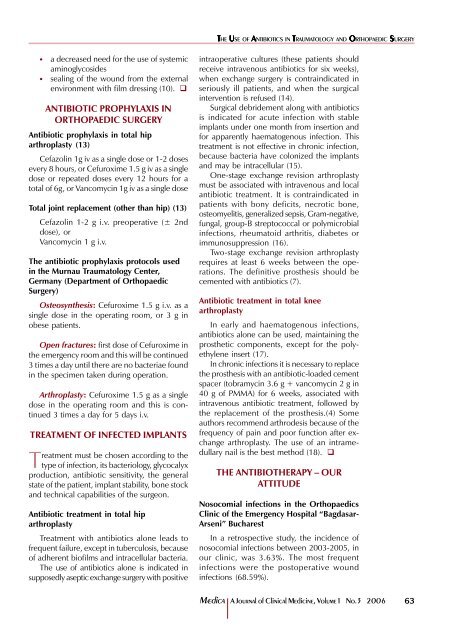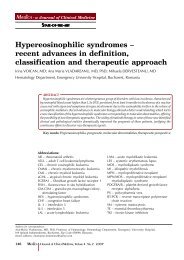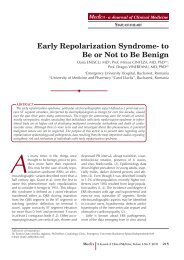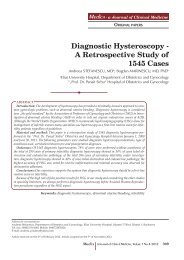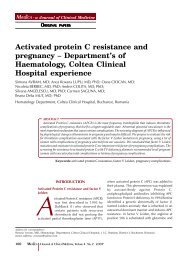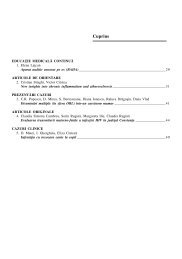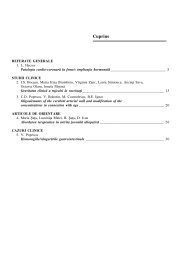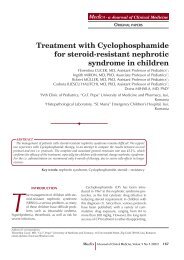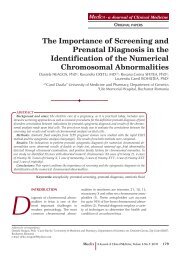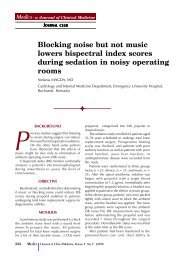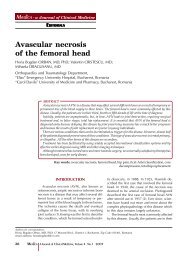The use of antibiotics in traumatology and orthopaedic surgery
The use of antibiotics in traumatology and orthopaedic surgery
The use of antibiotics in traumatology and orthopaedic surgery
Create successful ePaper yourself
Turn your PDF publications into a flip-book with our unique Google optimized e-Paper software.
� a decreased need for the <strong>use</strong> <strong>of</strong> systemic<br />
am<strong>in</strong>oglycosides<br />
� seal<strong>in</strong>g <strong>of</strong> the wound from the external<br />
environment with film dress<strong>in</strong>g (10). �<br />
ANTIBIOTIC PROPHYLAXIS IN<br />
ORTHOPAEDIC SURGERY<br />
Antibiotic prophylaxis <strong>in</strong> total hip<br />
arthroplasty (13)<br />
Cefazol<strong>in</strong> 1g iv as a s<strong>in</strong>gle dose or 1-2 doses<br />
every 8 hours, or Cefuroxime 1.5 g iv as a s<strong>in</strong>gle<br />
dose or repeated doses every 12 hours for a<br />
total <strong>of</strong> 6g, or Vancomyc<strong>in</strong> 1g iv as a s<strong>in</strong>gle dose<br />
Total jo<strong>in</strong>t replacement (other than hip) (13)<br />
Cefazol<strong>in</strong> 1-2 g i.v. preoperative (± 2nd<br />
dose), or<br />
Vancomyc<strong>in</strong> 1 g i.v.<br />
<strong>The</strong> antibiotic prophylaxis protocols <strong>use</strong>d<br />
<strong>in</strong> the Murnau Traumatology Center,<br />
Germany (Department <strong>of</strong> Orthopaedic<br />
Surgery)<br />
Osteosynthesis: Cefuroxime 1.5 g i.v. as a<br />
s<strong>in</strong>gle dose <strong>in</strong> the operat<strong>in</strong>g room, or 3 g <strong>in</strong><br />
obese patients.<br />
Open fractures: first dose <strong>of</strong> Cefuroxime <strong>in</strong><br />
the emergency room <strong>and</strong> this will be cont<strong>in</strong>ued<br />
3 times a day until there are no bacteriae found<br />
<strong>in</strong> the specimen taken dur<strong>in</strong>g operation.<br />
Arthroplasty: Cefuroxime 1.5 g as a s<strong>in</strong>gle<br />
dose <strong>in</strong> the operat<strong>in</strong>g room <strong>and</strong> this is cont<strong>in</strong>ued<br />
3 times a day for 5 days i.v.<br />
TREATMENT OF INFECTED IMPLANTS<br />
Treatment must be chosen accord<strong>in</strong>g to the<br />
type <strong>of</strong> <strong>in</strong>fection, its bacteriology, glycocalyx<br />
production, antibiotic sensitivity, the general<br />
state <strong>of</strong> the patient, implant stability, bone stock<br />
<strong>and</strong> technical capabilities <strong>of</strong> the surgeon.<br />
Antibiotic treatment <strong>in</strong> total hip<br />
arthroplasty<br />
Treatment with <strong>antibiotics</strong> alone leads to<br />
frequent failure, except <strong>in</strong> tuberculosis, beca<strong>use</strong><br />
<strong>of</strong> adherent bi<strong>of</strong>ilms <strong>and</strong> <strong>in</strong>tracellular bacteria.<br />
<strong>The</strong> <strong>use</strong> <strong>of</strong> <strong>antibiotics</strong> alone is <strong>in</strong>dicated <strong>in</strong><br />
supposedly aseptic exchange <strong>surgery</strong> with positive<br />
U<br />
A<br />
T<br />
THE UUSE<br />
U OF AANTIBIOTICS<br />
A<br />
IN TTRAUMATOLOGY<br />
T<br />
AND OORTHOPAEDIC<br />
O SSURGERY<br />
S<br />
Mædica A Journal <strong>of</strong> Cl<strong>in</strong>ical Medic<strong>in</strong>e, Volume1 No.3 2006 63<br />
O<br />
<strong>in</strong>traoperative cultures (these patients should<br />
receive <strong>in</strong>travenous <strong>antibiotics</strong> for six weeks),<br />
when exchange <strong>surgery</strong> is contra<strong>in</strong>dicated <strong>in</strong><br />
seriously ill patients, <strong>and</strong> when the surgical<br />
<strong>in</strong>tervention is ref<strong>use</strong>d (14).<br />
Surgical debridement along with <strong>antibiotics</strong><br />
is <strong>in</strong>dicated for acute <strong>in</strong>fection with stable<br />
implants under one month from <strong>in</strong>sertion <strong>and</strong><br />
for apparently haematogenous <strong>in</strong>fection. This<br />
treatment is not effective <strong>in</strong> chronic <strong>in</strong>fection,<br />
beca<strong>use</strong> bacteria have colonized the implants<br />
<strong>and</strong> may be <strong>in</strong>tracellular (15).<br />
One-stage exchange revision arthroplasty<br />
must be associated with <strong>in</strong>travenous <strong>and</strong> local<br />
antibiotic treatment. It is contra<strong>in</strong>dicated <strong>in</strong><br />
patients with bony deficits, necrotic bone,<br />
osteomyelitis, generalized sepsis, Gram-negative,<br />
fungal, group-B streptococcal or polymicrobial<br />
<strong>in</strong>fections, rheumatoid arthritis, diabetes or<br />
immunosuppression (16).<br />
Two-stage exchange revision arthroplasty<br />
requires at least 6 weeks between the operations.<br />
<strong>The</strong> def<strong>in</strong>itive prosthesis should be<br />
cemented with <strong>antibiotics</strong> (7).<br />
Antibiotic treatment <strong>in</strong> total knee<br />
arthroplasty<br />
In early <strong>and</strong> haematogenous <strong>in</strong>fections,<br />
<strong>antibiotics</strong> alone can be <strong>use</strong>d, ma<strong>in</strong>ta<strong>in</strong><strong>in</strong>g the<br />
prosthetic components, except for the polyethylene<br />
<strong>in</strong>sert (17).<br />
In chronic <strong>in</strong>fections it is necessary to replace<br />
the prosthesis with an antibiotic-loaded cement<br />
spacer (tobramyc<strong>in</strong> 3.6 g + vancomyc<strong>in</strong> 2 g <strong>in</strong><br />
40 g <strong>of</strong> PMMA) for 6 weeks, associated with<br />
<strong>in</strong>travenous antibiotic treatment, followed by<br />
the replacement <strong>of</strong> the prosthesis.(4) Some<br />
authors recommend arthrodesis beca<strong>use</strong> <strong>of</strong> the<br />
frequency <strong>of</strong> pa<strong>in</strong> <strong>and</strong> poor function after exchange<br />
arthroplasty. <strong>The</strong> <strong>use</strong> <strong>of</strong> an <strong>in</strong>tramedullary<br />
nail is the best method (18). �<br />
THE ANTIBIOTHERAPY – OUR<br />
ATTITUDE<br />
Nosocomial <strong>in</strong>fections <strong>in</strong> the Orthopaedics<br />
Cl<strong>in</strong>ic <strong>of</strong> the Emergency Hospital “Bagdasar-<br />
Arseni” Bucharest<br />
In a retrospective study, the <strong>in</strong>cidence <strong>of</strong><br />
nosocomial <strong>in</strong>fections between 2003-2005, <strong>in</strong><br />
our cl<strong>in</strong>ic, was 3.63%. <strong>The</strong> most frequent<br />
<strong>in</strong>fections were the postoperative wound<br />
<strong>in</strong>fections (68.59%).<br />
S


